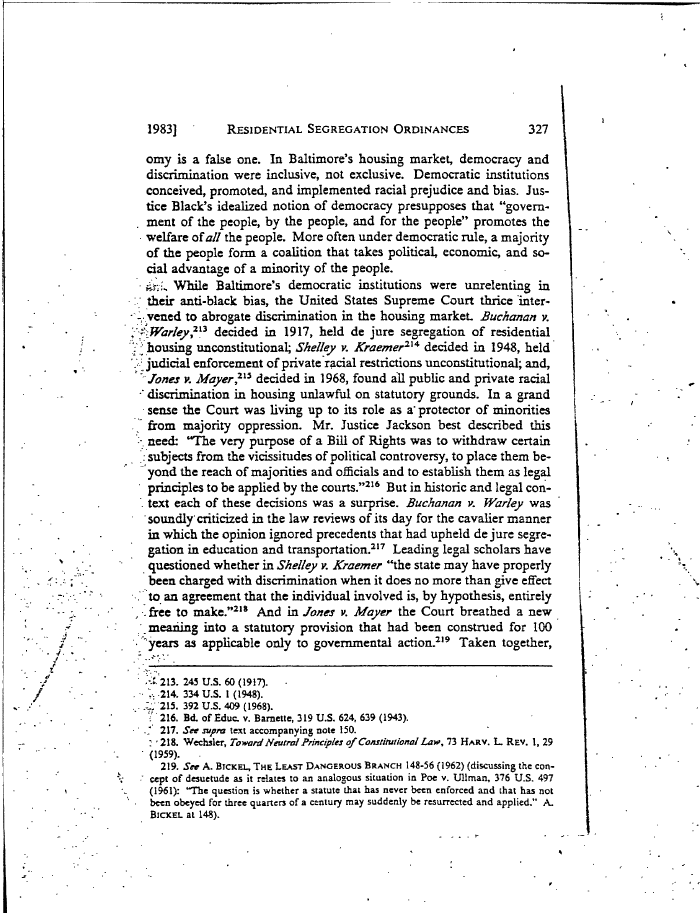 |
||||
|
Garrett Power, Apartheid Baltimore Style: The Residential Segregation Ordinances of 1910-1913, Maryland Law Review, 42 (1983) , Image No: 40 Enlarge and print image (68K) << PREVIOUS NEXT >> |
 |
||||
|
Garrett Power, Apartheid Baltimore Style: The Residential Segregation Ordinances of 1910-1913, Maryland Law Review, 42 (1983) , Image No: 40 Enlarge and print image (68K) << PREVIOUS NEXT >> |
| 1983] RESIDENTIAL SEGREGATION ORDINANCES 327 omy is a false one. In Baltimore's housing market, democracy and discrimination were inclusive, not exclusive. Democratic institutions conceived, promoted, and implemented racial prejudice and bias. Jus- tice Black's idealized notion of democracy presupposes that "govern- ment of the people, by the people, and for the people" promotes the welfare of all the people. More often under democratic rule, a majority of the people form a coalition that takes political, economic, and so- cial advantage of a minority of the people. While Baltimore's democratic institutions were unrelenting in their anti-black bias, the United States Supreme Court thrice inter- vened to abrogate discrimination in the housing market, Buchanan v. Warley™ decided in 1917, held de jure segregation of residential housing unconstitutional; Shelley v. Kraemer2** decided in 1948, held judicial enforcement of private racial restrictions unconstitutional; and, Jones v. Mayer,215 decided in 1968, found all public and private racial discrimination in housing unlawful on statutory grounds. In a grand sense the Court was living up to its role as a' protector of minorities from majority oppression. Mr. Justice Jackson best described this need: "The very purpose of a Bill of Rights was to withdraw certain subjects from the vicissitudes of political controversy, to place them be- yond the reach of majorities and officials and to establish them as legal principles to be applied by the courts.216 But in historic and legal con- . text each of these decisions was a surprise. Buchanan v. Warley was soundly criticized in the law reviews of its day for the cavalier manner in which the opinion ignored precedents that had upheld de jure segre- gation in education and transportation.217 Leading legal scholars have questioned whether in Shelley y. Kraemer "the state may have properly been charged with discrimination when it does no more than give effect to an agreement that the individual involved is, by hypothesis, entirely .free to make.218 And in Jones v. Mayer the Court breathed a new meaning into a statutory provision that had been construed for 100 "years as applicable only to governmental action.219 Taken together, 213. 245 U.S. 60 (1917). 214. 334 U.S. 1 (1948). 215. 392 U.S. 409 (1968). 216. Bd. of Educ. v. Barnette, 319 U.S. 624, 639 (1943). 217. See supra text accompanying note 150. 218. Wechsler, Toward Neutral Principles of Constitutional Law, 73 HARV. I_ REV. 1, 29 (1959). 219. See A. BICKEL, THE LEAST DANGEROUS BRANCH 148-56 (1962) (discussing the con- " cept of desuetude as it relates to an analogous situation in Poe v. UHman, 376 U.S. 497 (1961): "The question is whether a statute that has never been enforced and that has not been obeyed for three quarters of a century may suddenly be resurrected and applied." A. BICKEL at 148). |